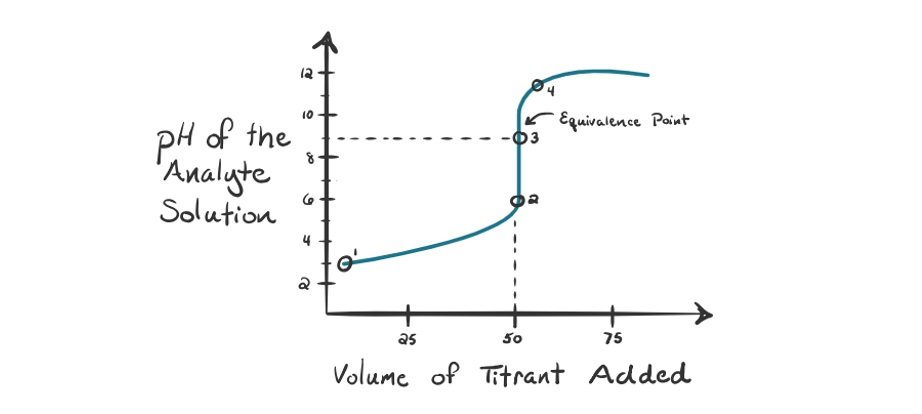Titration Curve and Conductivity graphs of Strong Acid/Strong Base
- A titration curve is the plot of the pH of the analyte solution vs the volume of the titrant added for the neutralization reaction to occur.
- A titration curve provides an idea regarding the equivalence point of an acid-base reaction, which is the exact phase in which the amounts of acid and base will be just precise for the reaction to occur.
- The graph also represents the pH value in the equivalence point which varies depending on how strong or weak the acids and bases are.
- For strong acid-strong base titration, pH = 7 at equivalence point
- For weak acid-strong base titration, pH > 7 at equivalence point
- For strong acid-weak base titration, pH < 7 at equivalence point
[Reference graph]
- Let us suppose that our analyte is HCl (strong acid) and the titrant is NaOH (strong base). The following graph is obtained:

- At point 1, the pH is low because NaOH has not yet been added and thus an acidic medium still persists. The only reaction happening here is the complete dissociation of HCl in water.
- pH at point 2 represents a state just before complete neutralization occurs.
- Point 3 is the equivalence point where the no. of moles of NaOH added equals the number of moles of HCl in the analyte. At this point, the neutralization reaction is complete and the pH value equals 7 since only NaCl and H2O are present in the solution.
- At point 4, the pH starts increasing, referring to a basic condition of the solution because of the presence of excess NaOH
- Conductivity Graph:
[Reference graph]

- Before NaOH is added, the conductance is high due to the presence of hydrogen ions.
- On addition of the base, the conductance falls due to the replacement of hydrogen ions by the added cation as H+ ions react with OH − ions to form undissociated water and the decrease in conductance continues until the equivalence point is reached.
- At the equivalence point, the solution contains only NaCl and the conductivity increases due to the presence of OH– in abundance.
Titration Curve and Conductivity graphs of Weak Acid/Strong Base
- Titration Curve:
[Reference Graph]

- The initial pH of the solution at the beginning of the titration is approximately that of the weak acid in water. As the reaction begins, the pH starts increasing.
- At the equivalence point, all of the weak acid is neutralized and converted to its conjugate base (the number of moles of H+ = added number of moles of OH–).
- The pH at the equivalence point does not equal 7 because of the production of conjugate base during the titration resulting the solution to be slightly basic.
- Conductivity Graph:
[Reference graph] - Initially the conductance is low for the fact that weak acids dissociate at a slower rate in water.

- On the addition of base, there is decrease in conductance due to the replacement of H+ by any other metal ion present in that particular base and common ion effect.
- On addition of more base, the conductivity increases as the base neutralizes the un-dissociated weak acid forming strong electrolytes (for example, if we use CH3COOH and NaOH as the weak acid and strong base, during the reaction, CH3COONa will be formed which is a strong electrolyte).
- This increase in conductance continues raise up to the equivalence point.
Titration Curve and Conductivity graphs of Weak Acid/Strong Base
- Titration Curve:
[Reference Graph]

- The initial pH at point 1 is comparatively low since the reaction has not begun yet and the solution contains acidic ions.
- On addition of base gradually, as the reaction begins, the pH starts increasing.
- At the equivalence point however, unlike the previous titration curves, the pH level does not indicate neutrality of reaction. In fact, the pH is ≈ 5.5 which is somewhat acidic. This happens because weak bases dissociate slowly in solution, allowing them to produce conjugate acids. These conjugate acids play contributing roles in the overall pH of the solution and thus even though the reaction reaches its equivalence point, the pH does not become neutral.
- As the base is gradually added more, after the equivalence point, the pH rises but is less than as compared to what it would have been in presence of a strong base (in case of strong bases, the pH rises almost at 13).
- Conductivity Graph:

[Reference graph]
- Initially the conductance is high due to faster dissociation of the strong acid in water. As the reaction proceeds and H+ ions are replaced, the conductivity starts decreasing.
- After the equivalence point is reached and all H+ ions are consumed, no significant change in conductivity is found and the graph becomes horizontal. This is because weak bases do not showcase very prominent conductivity and since their dissociation rate is slow, the resulting common ion effect at one point obstructs their dissociation. Thus, the conductance is unchanged.
Source:
